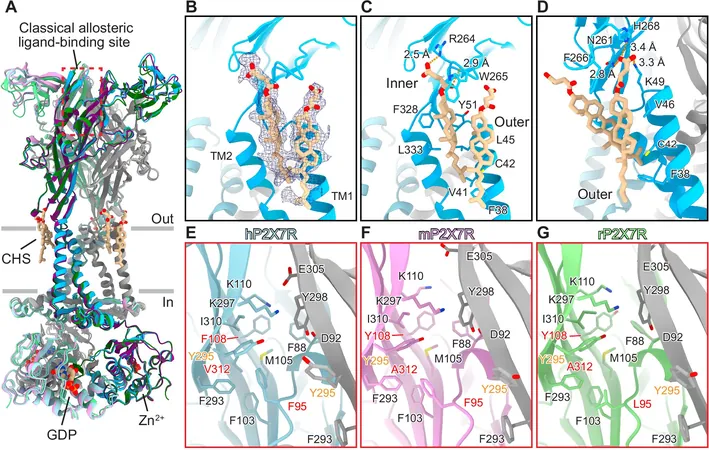
Groundbreaking Discoveries: How Cell Receptors Could Revolutionize Treatments for Diseases
2025-09-15
Author: Rajesh
Unlocking the Secrets of Cellular Receptors
In a remarkable breakthrough, scientists at Oregon Health & Science University have unveiled detailed mechanisms of specific molecular gates in human cells. This pivotal research could pave the way for novel therapies targeting a variety of diseases including certain cancers, brain disorders, hearing loss, and even atherosclerosis, which involves dangerous plaque buildup in the arteries.
The Pivotal Role of P2X Receptors
Led by Dr. Steven E. Mansoor, an associate professor specializing in cardiovascular medicine, this research focuses on a group of proteins known as P2X receptors. These receptors are essential players that reside on the surface of cells, detecting ATP—the energy currency of our bodies. When ATP leaks out of cells due to stress or damage, P2X receptors act as alarm systems, initiating inflammation, pain responses, and sensory processing.
"Extracellular ATP is a universal danger signal," Mansoor explains. "Understanding how these receptors function at the atomic level is crucial for developing drugs that can either inhibit or modulate their activity effectively."
Mapping the P2X7 Receptor for Future Drug Development
In a study featured in Nature Communications, the researchers explored the intricate structure of the human P2X7 receptor—a protein linked to multiple inflammatory diseases like cancer, Alzheimer’s, and atherosclerosis. Although significant progress has been made, no drugs targeting P2X7 have successfully navigated to market due to discrepancies between animal and human responses.
Building upon previous findings, the team successfully visualized how drugs can deactivate the human P2X7 receptor for the first time. Their understanding of the unique characteristics of the human version compared to animal models is a vital step toward tailoring drugs that fit precisely within the receptor’s binding sites.
Using this knowledge, researchers collaborated globally to design a groundbreaking compound, UB-MBX-46. This molecule fits seamlessly within the human receptor, offering a potent blockade with exceptional precision.
"For the first time, we've mapped the human P2X7 receptor and recognized what sets it apart from others," says graduate student Adam Oken. "With this insight, we can create drug candidates that slot into specific binding pockets, much like a key in a lock. This inspires hope for developing effective therapies that could finally make it to patients."
Revolutionizing Hearing Treatments
A second study published in Proceedings of the National Academy of Sciences delved into the human P2X2 receptor, another member of the P2X family predominantly located in the cochlea, the inner ear’s hearing organ. This receptor plays a significant role in hearing and the ear’s adaptation to loud sounds. Genetic mutations in this receptor have been associated with hearing loss, yet effective drugs remain elusive.
Lead researcher Franka Westermann, a Ph.D. student at the University of Bonn, utilized groundbreaking cryo-electron microscopy to capture the 3D structures of the human P2X2 receptor in both resting and desensitized states. This imaging technique revealed unique structural features and specific areas where hearing-related mutations transpire.
"Our findings illuminate the binding process of ATP and the receptor’s molecular transformations upon activation," Westermann stated. "Understanding the distinctions between P2X2 and P2X7 guides us in crafting tailored molecules that target specific receptors effectively."
Laying the Groundwork for Future Therapies
Together, these studies represent a significant advance in comprehending how P2X receptors influence an array of diseases through triggering inflammation and sensory alterations.
Dr. Mansoor emphasized, "This foundational research paves the way for creating selective molecules that tackle various human diseases. I'm actively steering my research towards these translational applications."


 Brasil (PT)
Brasil (PT)
 Canada (EN)
Canada (EN)
 Chile (ES)
Chile (ES)
 Česko (CS)
Česko (CS)
 대한민국 (KO)
대한민국 (KO)
 España (ES)
España (ES)
 France (FR)
France (FR)
 Hong Kong (EN)
Hong Kong (EN)
 Italia (IT)
Italia (IT)
 日本 (JA)
日本 (JA)
 Magyarország (HU)
Magyarország (HU)
 Norge (NO)
Norge (NO)
 Polska (PL)
Polska (PL)
 Schweiz (DE)
Schweiz (DE)
 Singapore (EN)
Singapore (EN)
 Sverige (SV)
Sverige (SV)
 Suomi (FI)
Suomi (FI)
 Türkiye (TR)
Türkiye (TR)
 الإمارات العربية المتحدة (AR)
الإمارات العربية المتحدة (AR)